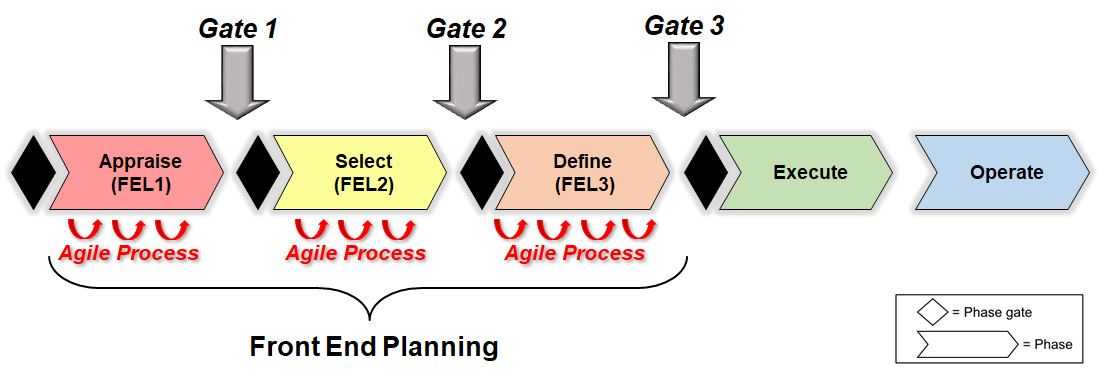There is a lot of buzz about the application of several, newer Project Management tools, practices, and processes within the engineering construction industry. Many of these new approaches have derived from other industries, such as the IT development industry. The most popular is Agile, which is an umbrella methodology that includes different approaches or frameworks such as Scrum, Kanban, Crystal, and so on. All these approaches adhere to the Agile methodology and its associated principles.
The engineering/construction industry has been applying the waterfall technique of project planning and delivery for over 50 years. The Front-End Loading (FEL) process which typically consists of 5 phases (FEL 1 – Appraise, FEL 2 – Select, FEL 3 – Define, Execution, and Operate) provides a sound framework for decision-making at key points in Owner project development and delivery based on the maturity of defined planning deliverables.

Although a sound process, many believe this approach is time-consuming and does not address the often schedule-driven nature of projects in our ever-changing, turbulent economic environment. The traditional process fixes requirements to control time and cost while Scrum, for example, fixes time and cost to control requirements. These two methodologies are not incompatible, on the contrary, they supplement each other during project life when applied correctly.
The new tools and techniques are more focused on speed of delivery which addresses the changing market economic conditions and competitive nature of the fast-paced IT project environment. Although these tools have a sound basis in the fast-paced, changing technology driven IT environment, they often struggle to provide the cost and schedule certainty that most of the Owner capital projects in the engineering/construction industry sectors require. What most of our clients are implementing is a combination of the typical waterfall decision making process (FEL) with and integration of the new project management techniques. For example, decisions that need to be made between FEL phase gates lend themselves well to the application of agile approaches developed with small teams in a scrum environment. This is similar to what was traditionally called a “war room” or today a “situation room”. These techniques can be very beneficial to solve quick issues in a collaborative environment while maintaining focus on safety, quality, cost, and schedule parameters.
The agile teams break large projects down into smaller pieces that are measurable, usable, and add value. After completing a small project piece, it can be submitted to the Client for review, comments, and approval. This does not happen with the traditional work breakdown structure. The scrum approach considers short iterative release cycles (named sprints) to guarantee regular delivery on a specific timeline. These timelines allow the project team to deliver often, reprioritize when needed and constantly improve. The project team meets frequently on a specific task/activity which was identified as a project backlog. The meetings include activities of planning, reviews, and retrospectives or lesson learned. The key in agile methodology is working in a collaborative environment with permanent feedback (concerns, barriers, changes, opportunities, risks, etc.) from the participants at these meetings. Continuous feedback and Client approval or suggestions for improvement within a time schedule promote team development and eliminate unnecessary stress and workload. If there are project issues, those are solved in a timely manner before they escalate allowing quick action, minimizing delays, and ensuring an uninterrupted flow of work.
It is more difficult to apply any of these Agile approaches during the project execution phase. However, some basic concepts can help to reduce costs in terms of materials, resources, overtime, better collaboration with minimum misunderstanding, decrease project delays, and better relationships with stakeholders who are well-informed and involved in the process. Experience has demonstrated that nothing can replace a thoughtful and accurate planning effort during the front-end loading phase in order not to cause changes during the execution phase.

We believe that a well-organized combination of traditional project delivery processes in combination with some of the newer techniques can provide excellent results in today's diverse, remote, and collaborative project environments. With this said, the foundational phase gate, front-end loading decision-making processes will still be the core project delivery approach for mid to mega-scale engineering, procurement, and construction projects within the energy sector. The links between these phase gate decisions and an owner organization’s capital funding process are an integral part of many owner project delivery systems. In today's owner capital project delivery world, cost certainty is paramount and only subservient to safety and ESG project drivers.
ABOUT THE AUTHORS

Steve Cabano
Steve is President/Chief Operating Officer for Pathfinder, LLC and has over 30 years of direct Project Management experience for Owner, Contractor, and Government clients in various industries.
slcabano@pathfinderinc.com
856-424-7100 x122

Maria Lizardo
Maria is a Vice President with Pathfinder, LLC and has over 40 years of experience in the Oil & Gas Industry.
mlizardo@pathfinderinc.com
856-424-7100 x137

